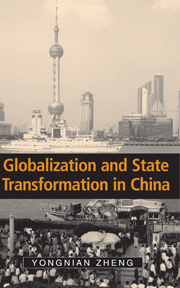Book contents
- Frontmatter
- Contents
- List of figures
- List of tables
- List of abbreviations
- Preface
- 1 Globalization: State decline or state rebuilding?
- 2 The state, leadership and globalization
- 3 Globalism, nationalism and selective importation
- 4 Power, interests, and the justification of capitalism: Constructing an interest-based political order
- 5 Bureaucratic reform and market accommodation
- 6 Building a modern economic state: Taxation, finance and enterprise system
- 7 State rebuilding, popular protest and collective action
- 8 Contending visions of the Chinese state: New Liberalism vs. the New Left
- 9 Globalization and towards a rule-based state governance?
- Notes
- Bibliography
- Index
- CAMBRIDGE ASIA-PACIFIC STUDIES
6 - Building a modern economic state: Taxation, finance and enterprise system
Published online by Cambridge University Press: 11 December 2009
- Frontmatter
- Contents
- List of figures
- List of tables
- List of abbreviations
- Preface
- 1 Globalization: State decline or state rebuilding?
- 2 The state, leadership and globalization
- 3 Globalism, nationalism and selective importation
- 4 Power, interests, and the justification of capitalism: Constructing an interest-based political order
- 5 Bureaucratic reform and market accommodation
- 6 Building a modern economic state: Taxation, finance and enterprise system
- 7 State rebuilding, popular protest and collective action
- 8 Contending visions of the Chinese state: New Liberalism vs. the New Left
- 9 Globalization and towards a rule-based state governance?
- Notes
- Bibliography
- Index
- CAMBRIDGE ASIA-PACIFIC STUDIES
Summary
The restructuring of the state bureaucracy deals largely with the relations between the state and market. It does not tell us how the Chinese government has used modern economic means to manage and regulate the economy. This chapter shifts to the latter aspect, focusing on the reforms in the key sectors of taxation, finance, and the enterprise system. In reforming China's fiscal and financial systems, the leadership sought to achieve two main goals. First, fiscal and financial reforms aimed to promote the development of the market economy by changing the relationship between the state and the enterprises, and second, the reforms were expected to build a modern state by managing the economy more efficiently and shifting economic power from local government to the central state. This chapter attempts to link the reforms in taxation, finance, and state-owned enterprises (SOEs) with state-building efforts by the leadership.
Taxation reform and the tax regime
China's fiscal system since the late 1970s has undergone a drastic transformation from a unitary system to a federal one. When the leadership first embarked on economic reform, it recognized that enterprises as well as local governments had to be provided with incentives to support the reform effort. This was achieved through fiscal decentralization. But this process augmented local autonomy at the expense of the center's fiscal capacity.
- Type
- Chapter
- Information
- Globalization and State Transformation in China , pp. 109 - 136Publisher: Cambridge University PressPrint publication year: 2003

